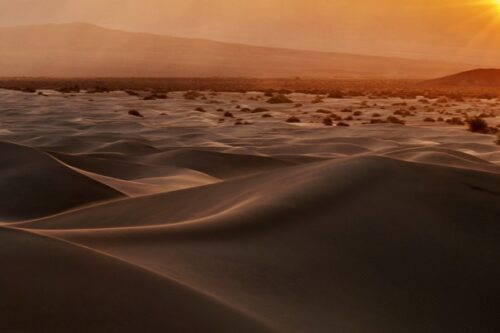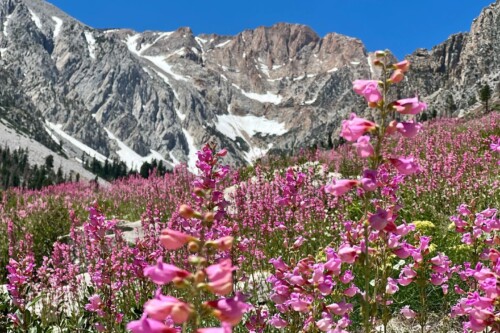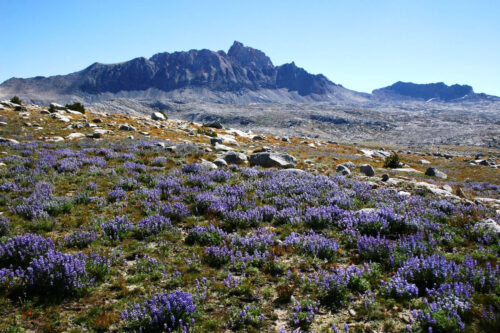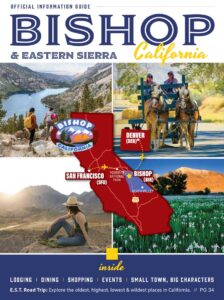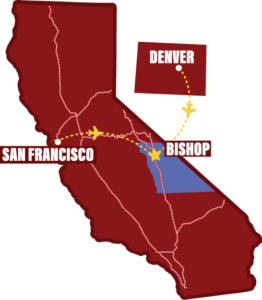Extreme Sierra. Extreme Events.
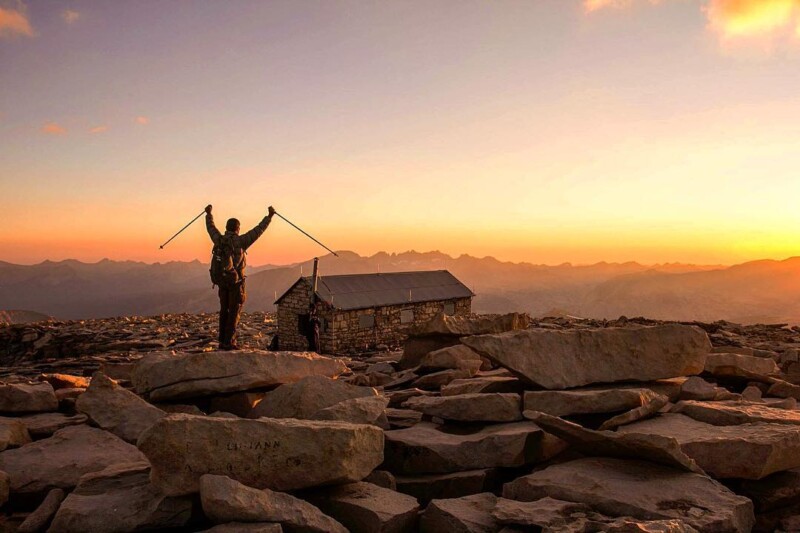
“On top of Mt. Whitney” Photo: Emiliano Reyna
Extreme Sierra
The Eastern Sierra is a land of extremes. There are extremes in temperature and climate, topography and geology, features of the fauna and flora, and in feats of human endeavor in the region.
Extreme Heat
Furnace Creek in Death Valley (163 miles southeast of Bishop) still holds the record for the highest temperature ever recorded on earth. On July 10, 1913, it was a blistering 134.1 degrees Fahrenheit. While there is some dispute by scientists about the accuracy of this recording the next hottest recorded temperature was also at Furnace Creek in Death Valley. What’s more, the average temperature during the month of July 2017 was 107.24 deg. F., making it the hottest single month ever reliably measured anywhere on Earth since records began in 1911. Now that’s pretty extreme.
Extreme Age
High above Bishop in the White Mountains are the world’s oldest living non-clonal organisms, the Great Basin Bristlecone Pine (Pinus longaeva). Growing between 9,800 and 11,000 feet in an all but inhospitable climate these trees live for thousands of years. There are few other living organisms that live to such extreme old age and none are nearly as old as the oldest of them, which is determined to be over 5,050 years old now.
Extreme Change
One of the most well-known geographical features of the area is that it is home to the lowest point and the highest point on the continental USA. Badwater Basin (near Furnace Creek) in Death Valley sits at 282 feet below sea level. It is not the lowest point on the earth, but ranking at number 8 on the list of “lowest exposed land on the earth’s surface” it definitely qualifies as extreme. What makes this all the more intriguing is that it is situated only 85 miles, straight-line distance, from the highest point in the country, Mt. Whitney. This summit is 14,505 feet above sea level, making this a dramatic rise of almost 15,000 feet from Badwater Basin in a relatively short distance.
There are numerous other places in the world where mountains rise up steeply more than 15,000 feet – consider the mountains of the Himalayas and the Andes. However, there are few if any other places that rise from below sea level to over 14,500 above sea level in so short a distance and display such entirely different climates at each point. It is extremely fascinating.
Extreme Challenge
Perhaps more fascinating than the extremes of nature are the extreme feats of daring, strength and ingenuity that humans have performed in this extreme landscape in which we live. The history books are full of the stories of explorers and adventurers who braved the elements and challenged themselves physically and mentally to achieve their objectives.
Men and women still participate in activities that require extreme fortitude. The Eastern Sierra is a mecca for sporting events that go beyond the realm of the usual.
Badwater to Whitney Portal Ultramarathon
“The World’s Toughest Foot Race.”
The distance by road between Badwater Basin and Mt. Whitney portal (elevation 8,300’), where the road ends at the trailhead for the hike up to the summit, is 135 miles. In the sporting discipline of ultra running, any race longer than a traditional marathon of 26 miles is classified as an ultramarathon. The STYR Labs Badwater 135 is not just ultra by this definition – it is extreme.
There is no ‘straight line elevation’ gain between these two points. The cumulative vertical ascent is 14,600’ and the cumulative descent is 6,100’. Athletes must cross three mountain ranges and vast stretches of desert with temperatures well over 100 degrees.
Entry to the race is by invitation only and 100 endurance athletes representing approximately twenty-five countries and twenty American states participate in the event. The official head-to-head race began in 1987 and has been held annually every year since then. It also holds the distinction of being conducted “without serious incident, fatality, or any citations issued by any branch of law enforcement” in all those years.
The race concept was born from one man’s solo attempt to make this crossing. Al Arnold, an ultrarunning pioneer known as the “joggernaut”, began his quest to run from Badwater to Whitney in 1974. His first attempt was aborted for dehydration and the second in 1975 for a knee injury. In 1976, injuries kept him from attempting it again, but in 1977 he succeeded and summited Mt. Whitney 80 hours after his start at Badwater.
Today the race does not summit the mountain due to regulations that no longer allow competitive events in the John Muir Wilderness. Nevertheless, according to race organizers, it is still considered, “the most demanding and extreme running race offered anywhere on the planet.”
L2H (Lowest to Highest)
This is not as much an event as it is a personal challenge. It is most assuredly a challenge of an extreme kind and even a visit to one of the websites that provides information on possible routes and what to expect has an ominous warning about the extreme nature of this challenge.
The challenge is to hike the backcountry from Badwater Basin to Mt. Whitney. Whereas this foot trek will take intrepid hikers to the summit of Mt. Whitney and the official running race ends at Whitney Portal, some 8 miles and several thousand feet below the summit, the distance covered is largely similar. The total distance covered is about 130 miles (depending on the precise route followed), but the total elevation gain more than doubles that of the highway route. Of course, there is one last challenge upon summiting the mountain, and that is to descend again or continue onto the John Muir Trail.
The hike is intended to be a journey of adventure across the wilderness by avoiding paved roads and vehicle traffic whenever possible. It is about walking and living (if only for a few days) in a land of extremes. There are greater extremes of geography, ecology and climate along this route than many other off-highway journeys. The hike requires careful advance planning. Travelers must arrange for their own resupply of food and water and it is necessary to obtain a permit to summit Mt. Whitney. The latter can be a challenge in itself as permits are booked months in advance and the permit date, once obtained, is not adjustable. However, neither this nor the route is insurmountable and many hikers have successfully traversed this rugged, harsh and extremely beautiful landscape.
The L2H hike will not fail to leave an indelible impression on your heart and soul.
Bishop High Sierra Ultra Marathons
For over 20 years trail runners have ascended to the ‘big backyard’ of Bishop to participate in this magnificent trail running event. The organizers of this race stage 4 distances in which runners may compete in 20-mile, 50-km, 50-mile or 100-km courses. For most non-runners, just the 20-mile “fun run”, as it’s billed, would seem extreme, but for seasoned long-distance trail runners, this extreme running event is as exhilarating as it is challenging.
The Bishop High Sierra Ultra Marathons start at an elevation of 4,429 feet with the highest point of the 100km course topping out at 9,360. The cumulative gain/loss of this race is more than simply the difference – it is 11,227 feet! In addition to the high elevation, athletes must be wary of obstacles, such as small rocks, roots and puddles along the trail, and deal with big changes in temperature and light. The races begin at dawn and the longest continues well into the night. Notwithstanding all this, applications to participate are generally oversubscribed and the event is limited to 250 participants.
It is one of the most spectacular events on the annual trail running calendar featuring wide-open views of the Owens Valley and the majestic Sierra Nevada soaring high above the race courses. There is a long-standing commitment from the residents of Bishop and the Eastern Sierra in support of this event and it is renowned for the quantity and quality of the aid stations and volunteers.
These 50-mile and 100-km courses are considered to be a perfect training opportunity for the 100-mile! mountain trail races that follow at other venues later in the year. Now that’s ultra-extreme!
June Lake Triathlon
While a standard triathlon event may not generally be considered as extreme as multi-sport and long-distance events go, the June Lake Triathlon does differentiate itself from other such events due to its magnificent high-altitude setting. June Lake, 56 miles north of Bishop, is nestled in the high alpine region of the Sierra Nevada at an elevation of 7,600 feet above sea level. This fact alone adds a level of difficulty to the physical challenge of the 6 races offered here. The event is touted as “The toughest race in the most beautiful place” and we believe it merits a listing in this list of extreme events.
Organizers of the event present races for a broad cross-section of ages and abilities. The event includes sprint, Olympic and Half-Ironman distances with categories for individuals, relay teams and aqua bike (biathlon of just the swim and cycle disciplines), plus a short course for children between the ages 6 – 12 years old.
It is a marvelous family fun event that has something for everyone who aspires to the good extremes of life.
Mammoth Gran Fondo
Where in the world is there a 100-mile road bike race with only one traffic light? The answer – the Eastern Sierra, Mammoth Lakes, 40 miles north of Bishop. The Mammoth Gran Fondo road race, previously known as the High Sierra Fall Century, is the preeminent cycling road race in the area.
It is fast becoming the norm for long-distance bike races to adopt the Italian concept of Gran Fondo, which translates to Big Rides, and offer a variety of timed race distances. This event presents three route options, 102-mile Gran Fondo, 70-mile Medio, and 42-mile Piccolo – all with timed results.
This is arguably one of the most beautiful and quiet rides anywhere in the world, with 75 miles of the Gran Fondo route closed to through traffic. The route delivers great uphill climbs interspersed with long, fast descents all set in a quiet landscape of sweeping vistas and towering mountains. Race organizers provide full SAG and tech support, 6 fully stocked aid stations, mid-way lunch for Gran Fondo and Medio riders, free on-course photographs of racers, promotional gifts, and a great after party.
It is extremely fun, challenging and breathtakingly beautiful.
Graniteman Challange
The Graniteman Challenge is as extreme as it sounds. It is a three-day, multi-sport event that challenges athletes to swim, bike, and run long distances that are each singularly challenging enough. Most athletes who participate in this event put their bodies to extreme physical tests for well over 9 hours cumulatively. Fewer than 5 participants to date have come in under 9 hours.
This weekend triathlon is held in conjunction with the Mammoth Gran Fondo and the Tioga Pass Run, which are scheduled on consecutive days during the first weekend of September. The swim portion of this triathlon is presented the day prior to the road race making this a weekend of extreme physical endurance for all who participate.
The challenge is named for the ‘granite-to-granite’ swim held in June Lake where 2.4 miles of swimming in the waters of this high alpine lake surrounded by towering granite cliffs can only be achieved by the hardiest of women and men.
The Tioga Pass Run, which is principally a stand-alone road running event, is a long-standing race that begins in Lee Vining, 64 miles north of Bishop, and follows the spectacularly scenic California State Route 120 into Yosemite National Park. The race ends at Tioga Pass, the entrance to the park. This 12.4-mile run, with a total elevation gain of 3,200 feet, is one of extreme beauty and significant challenge to all who undertake it.
Everest Challenge
This challenge must qualify as one of the most extreme cycling challenges in the USA. It is said for every cyclist who dreams of riding the Tour de France, this challenge is the chance to experience the kind of climbing for which “Le Tour” is famous. What’s more – it is said to be even tougher. The climbs are longer and tougher than any back-to-back stages of the Tour de France and three of the summits are much higher than any in the famous European race.
The Everest Challenge is a two-day, two-stage challenge that ascends and descends six of the most beautiful and brutal road bike climbs in California. These climbs are each challenging in their own right and to ride them consecutively, three on one day and three the next, is indeed an extreme endeavor. The challenge is named for the world’s highest mountain because, in just a little more than 200 miles of riding, the total elevation gain that every successful cyclist rides is 29,035 feet – as high as Mt. Everest.
In other words, this challenge is like riding two 100-mile bike races in two consecutive days with the added challenge of ascending well over 15,000 feet the first day and over 13,000 feet the next. Now that’s seriously extreme!
In years past this challenge was staged as a sanctioned and permitted competitive event with aid stations and SAG (support and gear) assistance. This is no longer the case, however, it can be done as an individual challenge and cyclists from around the country test their strength and endurance in these mountains every year.
Dual Sport Rally
A legal system of roads and trails for motorized vehicles was designated in the Eastern Sierra in 2009 following many years of inventory and analysis. This included public involvement to balance the needs for recreational opportunities and to protect the unique character of our public lands. The result is an extensive network of 2,200 miles of OHV trails and roads providing access through almost one million acres of the Inyo National Forest.
Every year dual sport motorcycle enthusiasts come to Bishop to spend a weekend in the mountains to test their mettle and their metal. Hosted by the Ventura County Motorcycle Club this event is offered to experienced dual sport riders only. While it is a fun family event the riding covers almost 800 miles of varying and difficult terrain. Riders can choose their own routes and help is always fairly close at hand, but the extreme nature of this mountainous region requires and high level of skill and experience.
The organizers, who present the event under permit from the US Forest Service and BLM (Bureau of Land Management), have a strict policy on bike setup, capability, fuel range capacity, licensing, and more. The event is restricted to 300 riders and it is often a sold-out event.
If you’re skilled and ready for some extreme high desert, or mountain riding – ride this extreme rally.
Pamper Pedal
Now that you’ve reached the end of this article do you find you’ve been waiting to exhale? Here’s a fabulous event that’s not extremely difficult but it is extremely fun!
The Pamper Pedal is the ‘glitz and glamour’ ride event of the year and it is reserved for women riders only. Men may participate by pampering the women on this fun ride by cheering them on and serving delicacies at any of the three aid stations along the route. It begins in Mammoth Lakes and ends in Bishop. The route is 48.7 miles long and has 1,323 feet of cumulative uphill (easy-peasy), and an extremely wonderful 5,025 feet of beautiful, sweeping downhill.
Now if all those previous events listed above are just a little too extreme for you come and give this one try. There is, however, the “Advanced” route option that includes a quick side trip up Pine Creek canyon, adding 15.7 miles and an extra 2,776 feet of climbing to the overall total.
Oh, you know, it’s the Eastern Sierra. We can’t do anything without adding something just a little extreme.
More About Extreme Sierra
Call the knowledgeable staff at the Bishop Visitor Center at (760) 873-8405 or come to 690 N. Main St. and get brochures, maps, and information on these events and much more to do in the Eastern Sierra.
